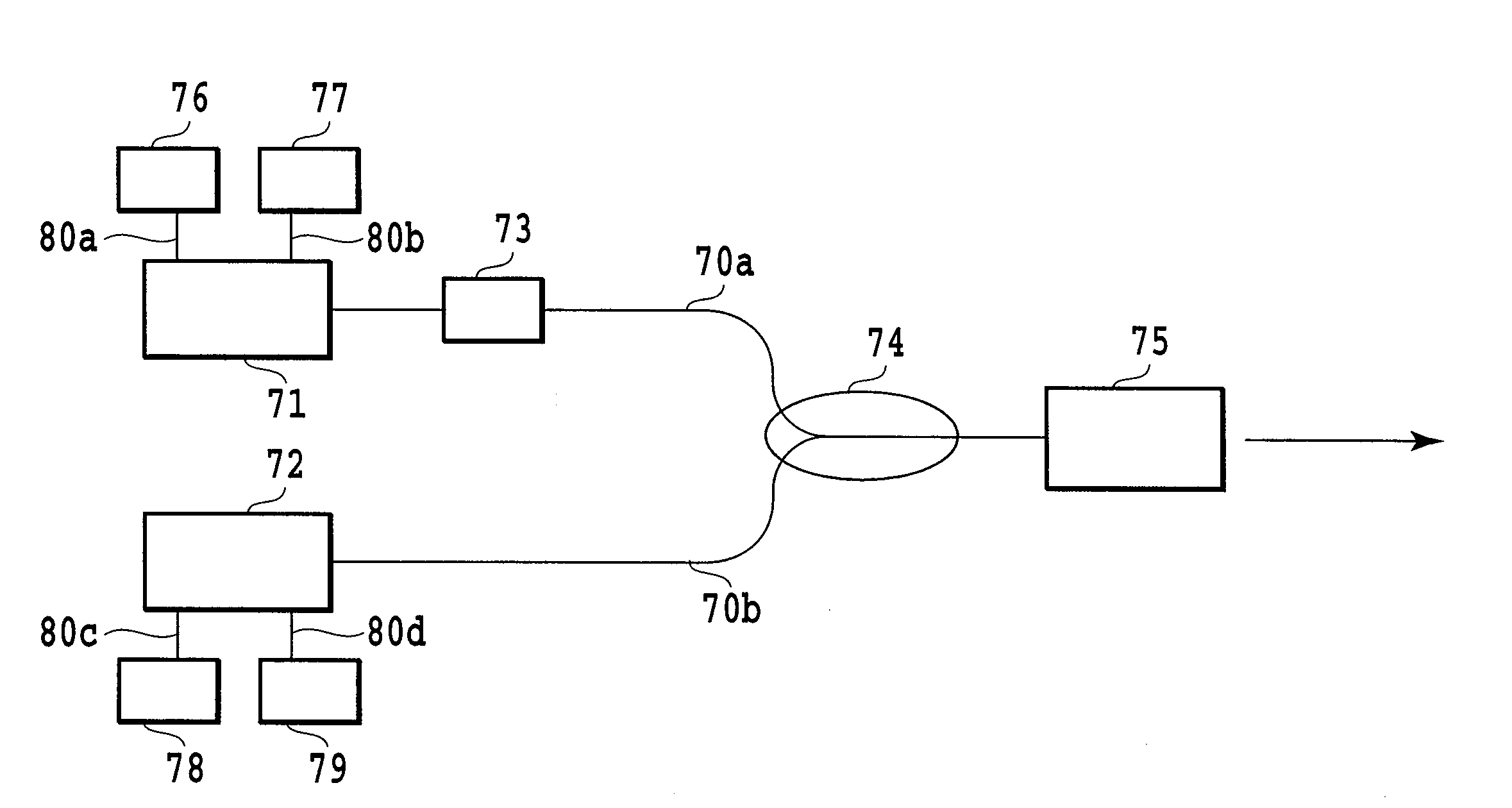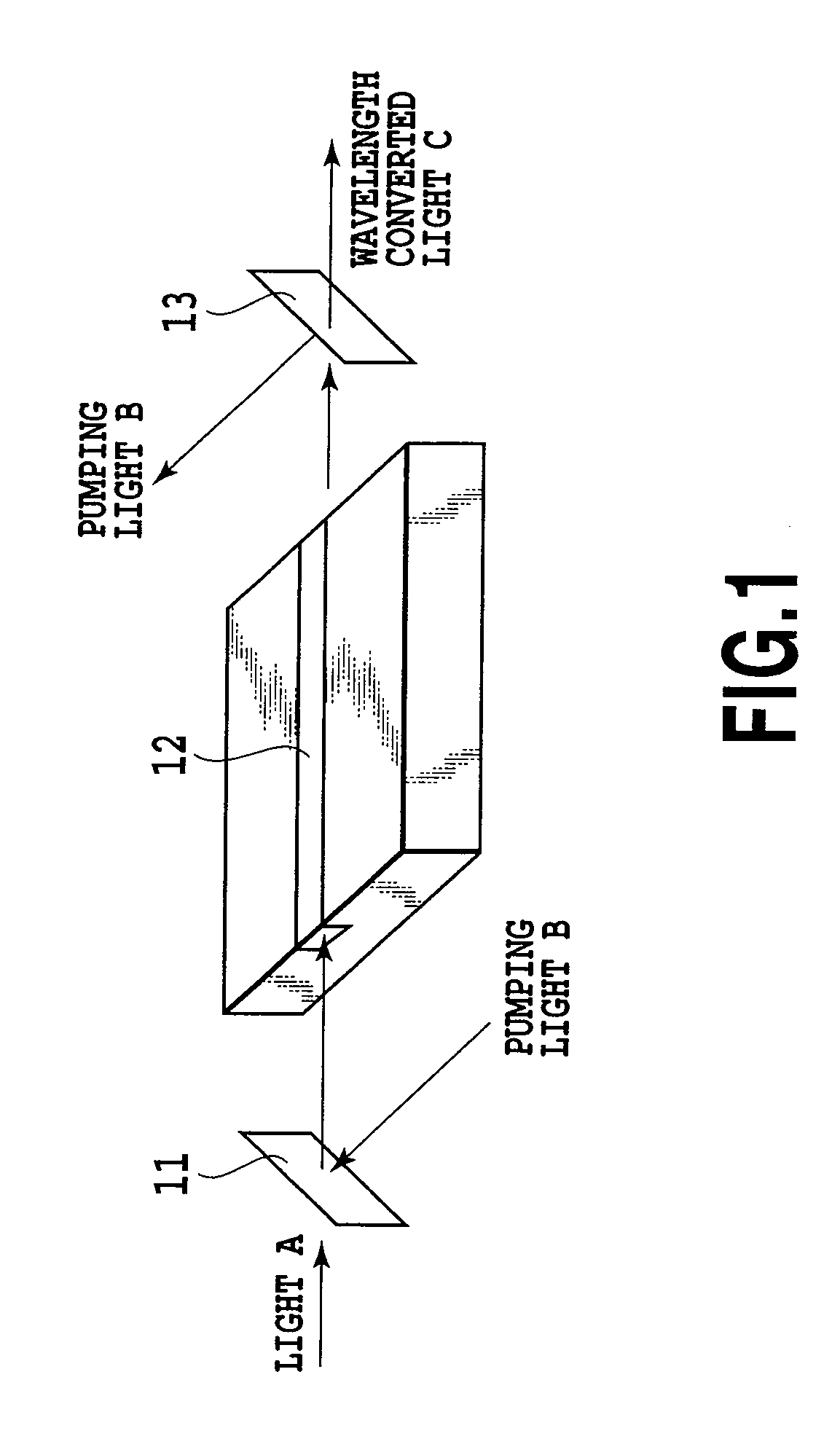Light source apparatus with modulation function and its driving method
a light source and function technology, applied in the field of visible, middle infrared or infrared light sources, can solve the problems of inability to implement laser oscillation over the entire wavelength domain, inability to implement on/off modulation function in light source, and inability to achieve the effect of increasing sensitivity
- Summary
- Abstract
- Description
- Claims
- Application Information
AI Technical Summary
Benefits of technology
Problems solved by technology
Method used
Image
Examples
embodiment 1
[0058]In the example 1, a wavelength conversion device module using LiNbO3 as the nonlinear optical material is fabricated, and a light source apparatus with modulation function is fabricated which outputs wavelength converted light by using as the pumping source a 1.064 μm semiconductor laser with an FBG for stabilizing the wavelength and a 1.32 μm-band wavelength variable laser.
[0059]FIG. 4 shows a fabrication process of the wavelength conversion device. In the example 1, the wavelength conversion device is fabricated by using a ridge waveguide structure using a direct junction substrate. More specifically, the wavelength conversion device is fabricated by joining a Z-cut, Zn-doped LiNbO3 substrate 51 that has a periodic polarization inversion structure formed in advance and that serves as a first substrate, and a Z-cut, Mg-doped LiNbO3 substrate 52 serving as a second substrate. Both the substrates are a 3 inch wafer whose both sides are optically polished, and are 300 μm thick. ...
embodiment 2
[0070]The example 2 employs the light source apparatus with modulation function with the same configuration as that of the example 1. Here, the driving conditions of the pulse driving power supply 77 are limited.
[0071]FIG. 8B illustrates the current-light output characteristics at that time. In the example 2, as in the example 1, the output light emitted from the 1.064 μm semiconductor laser 71, which has the FBG 73 stabilize the wavelength, has the smooth differential efficiency characteristics except for the positions at which the light output kinks take place.
[0072]First, the temperature control of the 1.064 μm-band semiconductor laser 71 is carried out so that the initial kink current value in the current-light output characteristics is set at nearly maximum. In this case, the lower limit of the current modulation range is set at a value equal to or less than the threshold value, and the upper limit is set at a current value slightly lower than the current value that will provid...
embodiment 3
[0073]FIG. 9 shows a light source apparatus with modulation function having an isolator 81 just behind the FBG 73. The input side fiber of the wavelength conversion device module 75 is fusion spliced to the output fiber of the 1.06 / 1.32 μm WDM coupler 74. Second, the 1.06 μm input fiber 70a of the WDM coupler 74 is fusion spliced to the isolator 81. In addition, the isolator 81 is fusion spliced to the FBG 73, and the FBG 73 is fusion spliced to the 1.064 μm-band semiconductor laser 71. Here, the FBG 73 is placed outside the 1.064 μm-band semiconductor laser 71. Furthermore, the 1.32 μm input fiber 70b of the WDM coupler 74 is fusion spliced to the output fiber of the 1.32 μm DFB laser 72. The 1.064 μm-band semiconductor laser 71 is connected to the temperature control unit 76 and to the pulse driving power supply 77 via the connecting lines 80a and 80b. The 1.32 μm-band DFB laser 72 is connected to the temperature control unit 78 and to the DC driving power supply 79 via the connec...
PUM
 Login to View More
Login to View More Abstract
Description
Claims
Application Information
 Login to View More
Login to View More - R&D
- Intellectual Property
- Life Sciences
- Materials
- Tech Scout
- Unparalleled Data Quality
- Higher Quality Content
- 60% Fewer Hallucinations
Browse by: Latest US Patents, China's latest patents, Technical Efficacy Thesaurus, Application Domain, Technology Topic, Popular Technical Reports.
© 2025 PatSnap. All rights reserved.Legal|Privacy policy|Modern Slavery Act Transparency Statement|Sitemap|About US| Contact US: help@patsnap.com



